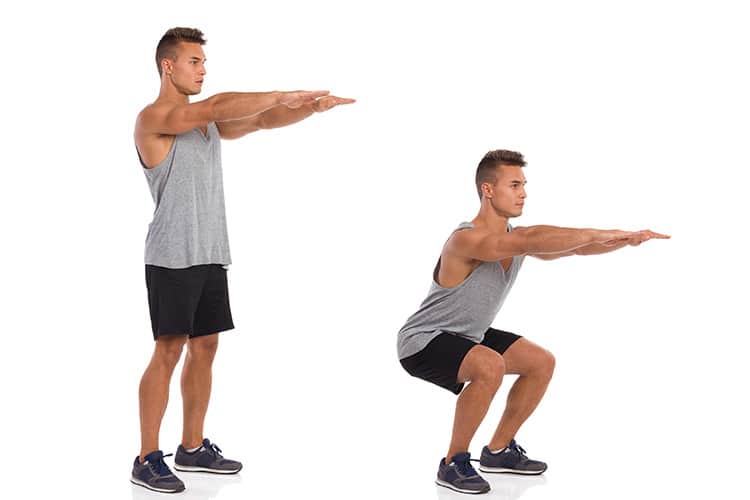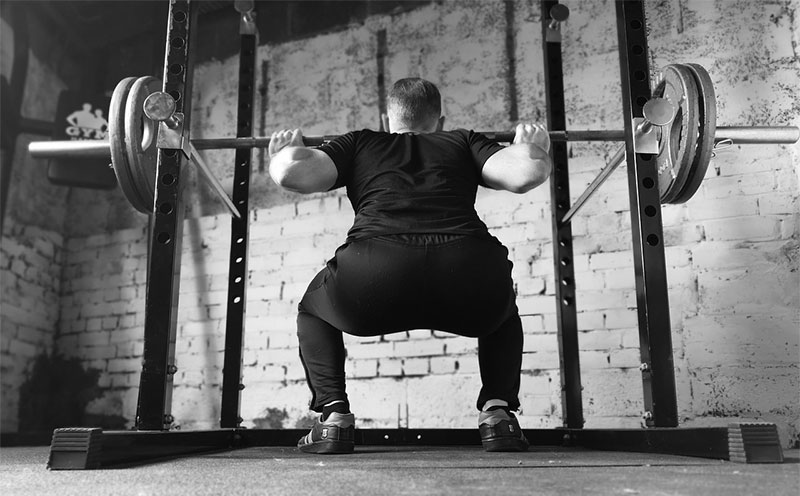A squat is a body dipping exercise in which a person lowers his hips toward the floor from a standing position and then returns to standing.
When weights are added, a squat becomes a powerlifting move, requiring both a burst of strength and continuous balance to return to upright.
The main benefits of squats are the strengthening and building of lower body muscles, but with increased strength comes numerous additional benefits, including improvements to balance and coordination.
What muscles do squats work?
Squats are powered mainly by the legs, but they are compound exercises that demand substantial balance as well, which keeps the core muscles actively engaged.
All leg muscles and joints are worked by squats, including the:
- Quadriceps
- Hamstrings
- Calf muscles
- Hip flexors
- Knees
- Ankles
The core muscles that engage during a squat to provide power and balance include the:
- Glutes
- Groin
- Abdominals
- Obliques
- Lower back/spine
By adding a squat bar with weight, a squat will also work your:
- Upper back
- Shoulders
- Chest
- Arms
A squat alone (no weight) works your body from the top of your rib cage down to your feet. Add weights, and a squat becomes a full-body exercise.
What do squats do?
Along with increasing strength and muscle mass, squats mainly enhance the posture.
The lower back muscles worked by squats are major supporters of the spine. Keeping these muscles fit strengthens the spine, enhancing back mobility and decreasing pain and injuries to the lower back.
Squats also build muscle mass in the legs, both upper and lower, and tone the glutes.
What are squats good for?
Squats are one of the most beneficial exercises you can do to stay in good shape for everyday living. A strong back makes long periods of sitting or standing less painful (though, it’s never recommended to remain in the same position for too long).
Sitting at a desk all day or working on a supermarket floor can both be hard on the body in different ways. A strong back will hold up better under pressure, helping to prevent repetitive use injuries and chronic pain.
The strength of the back is also a major determining factor in whether you will suffer acute injuries from common daily activities, such as bending and twisting.
Even basic movements like loading a dishwasher or reaching for the TV remote can cause injury if your back muscles are weak. This becomes truer the older you get as you experience age-related muscle loss.
Squats help keep muscle loss in the lower back to a minimum and ensure that the muscle that does remain is strong.

Squat Exercise Benefits
Along with the everyday benefits, squats are a great exercise for athletes looking to improve in their sports. This is especially true of sports that require substantial lower body strength.
Squats are so good at building muscle in the lower body, they improve explosive strength. Explosive strength includes movements like getting off the line in a sprint or breaking through the line in a football game.
Since squats also improve posture and balance, they are ideal training exercises for those sports that require good balance, like skiing, surfing, and mountain biking.
With any sport, adding squats to your exercise routine will strengthen the soft tissue and bones of the lower body, which can help prevent injury.
Squats Without Weights
Perhaps one of the best things about squats is that you don’t need any equipment to perform them. You can do a squat anywhere anytime.
Weightless squats don’t build as much muscle, or burn as many calories, as weighted squats. However, they still have a positive impact on lower-body strength and improve balance. If done rapidly, they will even provide some cardio benefit.
Squats With Weights
The traditional back squat, which incorporates a barbell across the shoulders, is what most people probably think of when they think of a squat.
The back squat puts more emphasis on the glutes and hips and incorporates every major muscle group.
Overhead squats are a slightly different weight-bearing squat that places the weight directly overhead. A barbell or exercise ball is held in extended arms above the head and the squat is performed as usual.
Due to the extension of the arms and distance of the weight from the body, overhead squats require more balance and put more emphasis on the core muscles.
Calories Burned with Squats
Squats are strength-building exercises, which means they burn fewer calories than cardio.
However, as a compound strength exercise that incorporates multiple major muscle groups, squats burn more calories than most other strength exercises.
Fast-paced squats can burn upwards of seven calories per minute, which is nearly twice the burn of a single muscle group exercise like a leg press.
Squats Calories Burned = 4-7 calories per minute
Afterburn
Generally speaking, the more muscle groups you engage during an exercise, and the larger those muscle groups, the more calories you burn post-workout.
Even without weights, squats use most of the largest muscle groups in the body – the upper leg, the lower leg, and the core. Add weights, and squats use every major muscle group.
Squats can increase afterburn by as much as double when intermixed with a cardio routine.
How many squats a day should I do?
Any amount of squats a day will improve leg strength and balance.
Start low with one set of five to ten squats. As you get used to doing squats, you can add more, doing as many as you feel comfortable doing as long as you are paying attention to your body and taking adequate rest between.
Can I squat everyday?
It depends on the type of squats you’re doing. If you’re doing weighted squats like back squats, you should perform them as you perform other strength-building exercises, skipping a day or two in between to give the muscles a chance to heal.
Weightless squats, when performed properly, puts very little strain on joints and muscles. Most people can do at least one set of weightless squats per day without issue.
Can I lose belly fat by doing squats?
Very little, if any.
Due to their engagement of the abdominals and the obliques, abs can tone the stomach muscles. However, squats are a muscle-builder, not a fat-burner.
Jump squats, which consist of an added jump at the top of a squat, are more of a cardio activity than traditional squats. You will burn more fat and calories with jump squats, but it’s still unlikely you’ll burn belly fat from squats alone.
Can squats make your butt bigger?
There is no “can” about it. Squats will make your butt bigger, at least temporarily.
Squats build and lift the glutes, which not only makes them bigger, but makes them stick out more. The only way to counteract this is to burn butt fat, which requires calorie/fat-burning cardio and a healthy diet.
Will squats make my thighs bigger?
Yes, most likely.
Thighs will experience the same muscle growth as the glutes, which means the thighs will look bigger. Getting rid of the layer of fat over the muscle on the thighs is the only way to counteract this.
Should I do squats?
Yes, yes, a resounding yes.
Squats may grow some areas that are notoriously problematic, especially for women – the butt and the thighs – but their positive impact on posture, balance, and lower body strength cannot be overstated.
Adding squats to a well-rounded exercise program that includes cardio (fat-burning) will result in less growth than doing squats alone, and can keep you healthy, balanced, and free from injury.

